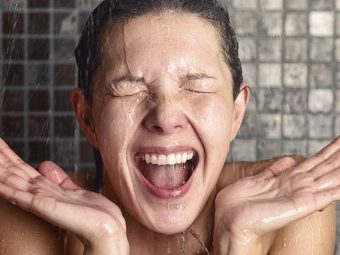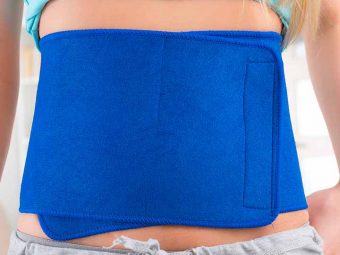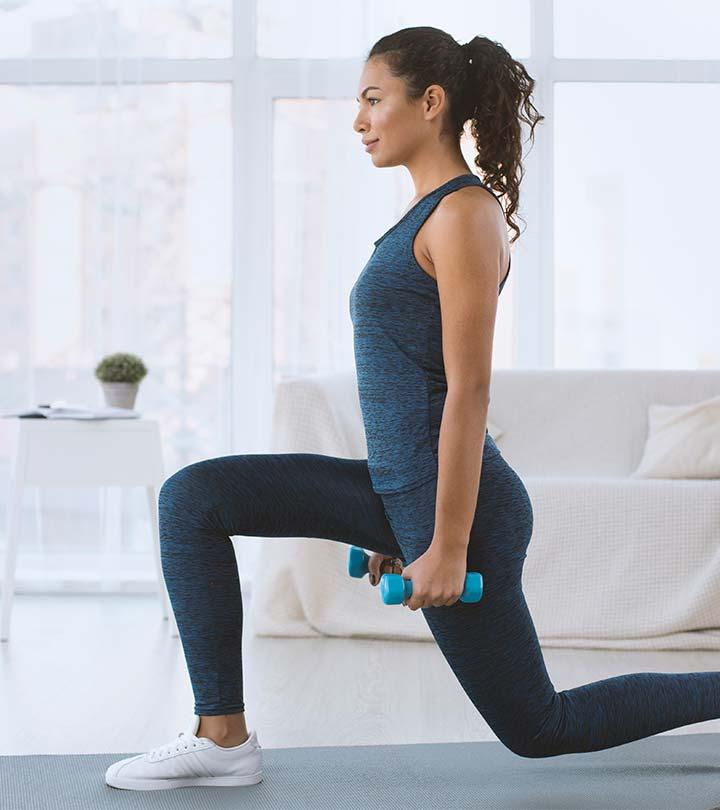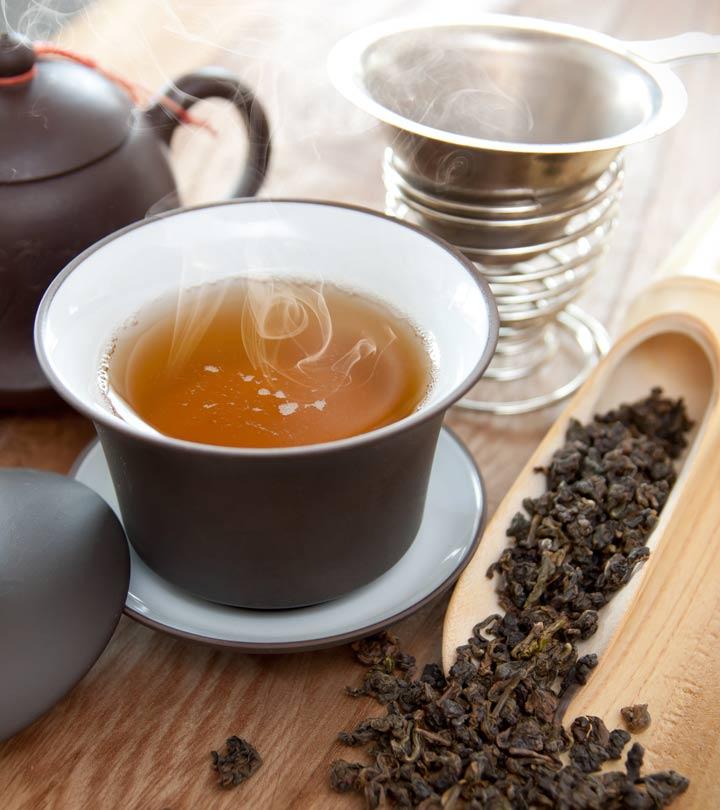Steam Vs. Sauna – Which One Is Best For Weight Loss? (Benefits And Health Risks)
Learn how both these heat therapies can improve your holistic health condition.

Image: Shutterstock
Shedding water weight has become easier with a steam bath! And while many ask if a sauna is good for losing belly fat, there are many benefits of a steam bath for weight loss.
But no, a steam bath is not a sauna. Sauna is a dry session while a steam bath is wet. Both can, however, aid weight loss, promote relaxation and make you feel pampered (1).
How good is a steam bath for weight loss? How does it aid weight loss? How long should the session last? Get all your questions answered in this post. Continue reading.
In This Article
Sauna Vs. Steam Room
Steam rooms are similar to saunas. They both involve using heat therapy in a small, closed room to lose water weight. The only difference is that a sauna uses dry heat from heated stones, wood, or gas stoves while a steam room uses wet heat from boiling water.
A sauna uses 180° to 195° F heat with low humidity while a steam room uses 100° to 120° F heat with 100% humidity. Both steam and sauna are claimed to help increase circulation and release toxins from the body to aid weight loss (1).
 Trivia
TriviaBut, the question remains – how does it work? Find out more in the next section.
How Do Sauna And Steam Room Help You Lose Weight?

Steam room therapy is considered to be a great detoxifier (1). Steam opens up your pores, helps in cellulite reduction, and enhances your body’s potential to eliminate toxins through sweat (2), (3). The more you sweat, the more water weight you lose (3).
1 liter of water lost through sweat leads to about 1 kg of weight loss (4).
A study published in the Scientific World Journal found that body mass loss (BML)i XThinning of muscle mass due to disuse of muscles and resulting in numbness and a tingling sensation in the limbs. as a result of sauna use is greater in overweight individuals than underweight and normal individuals (5).
Another study found that exercise along with sauna helps reduce body weight in obese individuals (6).
However, it is important to note that a one-time sauna or steam session is not effective for losing weight. Following a balanced diet with an exercise regimen and 10-12 sessions of sauna help improve your overall body composition (4).
A 1-hour sauna session twice a week for 7 days not only reduces body weight but also increases the metabolic rate by 25%-33% (7).
Still confused about which one to use, sauna or steam room? Read the next section to figure it out.
Steam Room Vs. Sauna For Weight Loss – Which One To Use?
Both steam rooms and saunas use heat therapy to relax the body, mind, and soul.
Using a steam room after exercise helps you sweat a lot, thus releasing more toxins. On the other hand, sitting in a sauna is like walking on a treadmill. The dry heat makes your heart pump harder to circulate more blood, thus creating a cardio effect.
You can choose between a steam room and sauna therapy for weight loss, depending on your comfort and accessibility. Start slowly and spend 10-15 minutes in either one to lose some weight.
 Quick Tip
Quick TipNow, let’s check out the other health benefits of steam room and sauna besides body weight.
Benefits Of Steam Room And Sauna
1. May Improve Cardiovascular Health
Steam therapy or frequent sauna usage may improve your cardiovascular health (8).
A study conducted in Poland found that 2 weeks of repeated sauna sessions help reduce the total cholesterol and triglyceridei XA type of converted fat in the blood that is used by the body between meals and may cause heart disease and strokes. level. It also helps improve cholesterol levels to prevent cardiovascular disordersi XA group of diseases that affect the heart and blood vessels and increase the risk of high blood pressure and other diseases. (9), (10).
However, further research is required to establish a direct relationship between steam/sauna sessions and improved cardiovascular health.
Keltie O’Connor, a lifestyle content creator, tried the sauna for a month and saw visible changes in her heart rate variability. She found this to be an effective solution to improve her heart health. She says, “It’s like one of my tool kits now. My health stats HRV improved by an average 15 to 30 (i)”.
2. Lowers Blood Pressure
Frequent sauna sessions may help improve circulation and reduce the risk of hypertensioni X A common condition in which the blood pressure is too high due to plaque buildup, medications, or kidney diseases. .
Regular sauna therapy increases the heart rate and improves blood circulation, thereby reducing blood pressure. However, further studies are required to elucidate the effects of sauna bathing on the cardiovascular system (11).
3. May Stimulate The Immune System
Different forms of hydrotherapyi XA branch of alternative medicine that uses water to treat pain and various symptoms throughout the body. , dry and wet, are effective in boosting the immune system. Sauna bath increases the number of white blood cells in the body, which stimulates the immune system (12).
A study conducted in Austria found that regular sauna bathing reduces the incidence of the common cold. However, further studies are required to prove this conclusively (13).
4. May Loosen Stiff Joints
Infrared sauna is said to be effective in loosening stiff joints. A study published in the Clinical Rheumatology found that this type of sauna helps with pain relief, stiffness, and fatigue in people with rheumatoid arthritisi XAn autoimmune inflammatory disease where the immune system attacks its own healthy cells, causing inflammation and pain in the joints. and ankylosing spondylitisi XAn inflammatory condition that causes spinal bones to fuse, resulting in reduced flexibility and hunched-forward posture. (14).
Another study published in the Medical Science Monitor stated that heat therapy is important to loosen joint stiffness and enhance muscle and ligament flexibility. It may also help reduce athletic injuries (15).
5. May Reduce Stress

Steam room/sauna sessions may be effective in reducing stress, depression, and anxiety.
A study published in JAMA Psychiatry found that whole-body hyperthermia (heat therapy) has the potential to become a safe and rapid-acting antidepressant and stress-relief treatment with long-term therapeutic benefits (16), (17).
Sauna bathing also relaxes your mind, body, and soul to improve the symptoms of psychiatric disorders like depression, anxiety, and stress (17). According to a population-based study conducted on people with dementia and Alzheimer’s disease, sauna bathing was seen as positively countering their impact. The moderate to high frequency of sauna bathing is associated with lowered risks of dementia and Alzheimer’s disease. Thus, it may help promote mental wellness (18).
6. May Improve Respiratory Function
Steam inhalation clears nasal blockages and reduces headaches by promoting respiratory health. A prospective controlled evaluation of steam therapy found it effective in decreasing respiratory distress in people with bronchiolitisi XA viral lung infection that commonly occurs in the winter and causes inflammation and congestion in the airways. (19).
Steam inhalation opens the mucous membrane of the nasal cavity. This helps a person take deep breaths, which provides relief from recurrent sinus symptoms (20).
7. Delayed Muscle Soreness
Steam room therapy is an excellent way to reduce muscle soreness after a workout.
A study published in the Journal of Clinical Medicine Research found that post-workout steam bath or sauna therapy increases deep tissue blood flow, thus providing muscle tension relief (21).
8. Promotes Skin Health
Regular sauna bathing may help improve the skin barrier function and keep your skin hydrated. As per one study, regular sauna bathing may help your skin retain water or moisture. It may also help improve blood flow to the skin, change sweat composition, and reduce skin oiliness, indicating potential benefits for skin health, particularly in maintaining balanced pH levels and retaining moisture (22).
Though steam rooms and saunas provide many health benefits, they also come with their fair share of risks. Check them out in the next section.
Risks Of Steam Room Or Sauna Use
- Sauna or steam therapy for more than 20 minutes causes you to sweat more. This can lead to dehydration and hyperthermia (increase in body temperature), especially in people who are overweight (23).
- A steam room is a great site for the growth of bacteria and germs as it is hot and humid. This could lead to the spread of infections and diseases.
- The heat of the sauna may cause cholinergic urticaria (hives on the skin caused by raised body temperature) (24).
Caution: If you are pregnant, lactating, or recovering from surgery, consult a doctor before using a sauna or steam room.
Additionally, here are some precautions you should take when using a steam room or sauna.
Precautions
- Avoid drinking alcohol before and after a steam bath.
- Do not extend any heat therapy for more than 20 minutes.
- Cool down gradually after taking a steam/sauna bath.
- Drink adequate water after a steam/sauna session for body and skin hydration.
Infographic: Key Points Of Comparison Between Steam And Sauna For Weight Loss
You can opt for both steam and sauna or pick one over the other to meet your quick weight loss goals. Here’s an infographic with the major points of comparison between the two summed up so that you can make up your mind in a jiffy. Illustration: StyleCraze Design Team
The benefits of steam baths for weight loss are well-established. It detoxifies your body by discharging toxins through sweat and also aids in boosting energy. Losing a liter of sweat is equal to losing one kilogram of weight loss. Sauna also has similar benefits, but it uses dry heat instead of wet heat. However, a single session of these baths won’t help much. You need at least 10-12 sessions, coupled with the right diet and frequent exercise, to see significant weight loss. Besides weight loss, these baths also help improve cardiovascular and digestive health, manage hypertension and body detoxification, and stimulate immunity. So, try out the bath of your choice and begin your weight loss journey through a healthy lifestyle.
Frequently Asked Questions
How many calories do you burn in a steam room in 15 minutes?
You can lose anywhere between 20-40 calories sitting in a steam room for 15 minutes. The number of calories you burn depends on your body weight and lifestyle.
How long should you stay inside a steam room?
You should stay for not more than 15-20 minutes inside a steam room.
How much weight loss is possible in a steam bath?
You can only lose water weight, which varies by your body water percentage, in a steam bath. You may lose 0.5-1 kg per session.
Is it OK to use a steam room every day?
Using a steam room every day is not advisable as it may lead to dehydration. Limit this heat therapy to 2-3 times a week.
Can steam reduce belly fat?
Steam room treatment can help reduce overall water weight, but not particularly belly fat.
Does steam cause hair loss?
Direct steam may loosen the hair follicles. Thus, it is always better to wear a shower cup before heading to a steam room or sauna.
Are steam rooms bad for your lungs?
Steam rooms clear out mucus and nasal blockages. But if you have a severe lung problem, it is better to consult a doctor before heading to a steam room.
Should I shower after sitting in a steam room?
Yes, you should take a shower as cooling down your body after taking a steam bath is extremely important.
Does a steam bath help with bloating?
Water from your body is expelled during a steam bath. Therefore, it may help remove the excess water in your body that is causing bloating.
What should you wear in a steam bath?
It is best to wear minimal clothes inside a steam room. You may wear a towel and shower shoes.
Is the steam room good for water retention?
Yes, a steam room helps remove excess water from your body and reduce water retention.
Key Takeaways
- Steam rooms increase your body’s capacity to sweat out toxins and experience better metabolism.
- Sauna sessions, a healthy diet, and regular exercise may help obese people lose body weight.
- Both steam rooms and saunas increase circulation and may help in the body’s toxin release.
- Sauna may reduce joint stiffness, promote muscle recovery, and ligament flexibility.
- Steam or sauna sessions may help to relax tense muscles and reduce physical discomfort caused by stress and anxiety.
References
Articles on StyleCraze are backed by verified information from peer-reviewed and academic research papers, reputed organizations, research institutions, and medical associations to ensure accuracy and relevance. Read our editorial policy to learn more.
- Hussain, Joy, and Marc Cohen. “Clinical effects of regular dry sauna bathing: a systematic review.” Evidence-Based Complementary and Alternative Medicine 2018 (2018).
https://www.ncbi.nlm.nih.gov/pmc/articles/PMC5941775/ - Maybhate, C. “Skin Care for Acne-Prone Skin.” Ayurveda Holistic Community (2005): 1-5.
https://www.ncbi.nlm.nih.gov/books/NBK279208/ - Podstawski, Robert, et al. “Sauna-induced body mass loss in young sedentary women and men.” The Scientific World Journal 2014 (2014).
https://www.ncbi.nlm.nih.gov/pmc/articles/PMC4295591/ - Podstawski, Robert, et al. “Correlations between Repeated Use of Dry Sauna for 4 x 10 Minutes, Physiological Parameters, Anthropometric Features, and Body Composition in Young Sedentary and Overweight Men: Health Implications.” BioMed research international 2019 (2019).
https://www.ncbi.nlm.nih.gov/pmc/articles/PMC6360547/ - Podstawski, Robert, et al. “Sauna-induced body mass loss in young sedentary women and men.” The Scientific World Journal 2014 (2014).
https://pubmed.ncbi.nlm.nih.gov/25614882 - Westerterp-Plantenga, Margriet S., et al. “Acute effects of exercise or sauna on appetite in obese and nonobese men.” Physiology & behavior 62.6 (1997): 1345-1354.
https://pubmed.ncbi.nlm.nih.gov/9383124 - Leppäluoto, J., et al. “Some cardiovascular and metabolic effects of repeated sauna bathing.” Acta physiologica scandinavica 128.1 (1986): 77-81.
https://pubmed.ncbi.nlm.nih.gov/3766176 - Vuori, I. “Sauna bather’s circulation.” Annals of clinical research 20.4 (1988): 249-256.
https://pubmed.ncbi.nlm.nih.gov/3218896 - Pilch, Wanda, et al. “Changes in the lipid profile of blood serum in women taking sauna baths of various duration.” International journal of occupational medicine and environmental health 23.2 (2010): 167.
https://pubmed.ncbi.nlm.nih.gov/20682487 - Gryka, Dorota, et al. “The effect of sauna bathing on lipid profile in young, physically active, male subjects.” International journal of occupational medicine and environmental health 27.4 (2014): 608-618.
https://pubmed.ncbi.nlm.nih.gov/25001587 - Zaccardi, Francesco, et al. “Sauna bathing and incident hypertension: a prospective cohort study.” American journal of hypertension 30.11 (2017): 1120-1125.
https://pubmed.ncbi.nlm.nih.gov/28633297 - Pilch, Wanda, et al. “Effect of a single finnish sauna session on white blood cell profile and cortisol levels in athletes and non-athletes.” Journal of Human Kinetics 39.1 (2013): 127-135.
https://www.ncbi.nlm.nih.gov/pmc/articles/PMC3916915/ - Ernst, E., et al. “Regular sauna bathing and the incidence of common colds.” Annals of medicine 22.4 (1990): 225-227.
https://pubmed.ncbi.nlm.nih.gov/2248758 - Oosterveld, Fredrikus GJ, et al. “Infrared sauna in patients with rheumatoid arthritis and ankylosing spondylitis.” Clinical rheumatology 28.1 (2009): 29.
https://pubmed.ncbi.nlm.nih.gov/18685882 - Petrofsky, Jerrold Scott, Michael Laymon, and Haneul Lee. “Effect of heat and cold on tendon flexibility and force to flex the human knee.” Medical science monitor: international medical journal of experimental and clinical research 19 (2013): 661.
https://www.ncbi.nlm.nih.gov/pmc/articles/PMC3747018/ - Kowatzki D, Macholdt C, Krull K, Schmidt D, Deufel T, Elsner P, Fluhr JW. “Effect of regular sauna on epidermal barrier function and stratum corneum water-holding capacity in vivo in humans: a controlled study.” Dermatology. 2008;217(2):173-80.
https://pubmed.ncbi.nlm.nih.gov/18525205/ - Janssen, Clemens W., et al. “Whole-body hyperthermia for the treatment of major depressive disorder: a randomized clinical trial.” JAMA psychiatry 73.8 (2016): 789-795.
https://pubmed.ncbi.nlm.nih.gov/27172277 - Laukkanen T, Kunutsor S, Kauhanen J, Laukkanen JA. “Sauna bathing is inversely associated with dementia and Alzheimer’s disease in middle-aged Finnish men.” Age Ageing. 2017 Mar 1;46(2):245-249.
https://pubmed.ncbi.nlm.nih.gov/27932366/ - Laukkanen, Tanjaniina, Jari A. Laukkanen, and Setor K. Kunutsor. “Sauna bathing and risk of psychotic disorders: a prospective cohort study.” Medical Principles and Practice 27.6 (2018): 562-569.
https://www.ncbi.nlm.nih.gov/pmc/articles/PMC6422146/ - Singh, M. E. E. N. U., S. U. N. I. T. Singhi, and B. N. Walia. “Evaluation of steam therapy in acute lower respiratory tract infections: a pilot study.” Indian pediatrics 27.9 (1990): 945-951.
https://pubmed.ncbi.nlm.nih.gov/2286438 - Little, Paul, et al. “Effectiveness of steam inhalation and nasal irrigation for chronic or recurrent sinus symptoms in primary care: a pragmatic randomized controlled trial.” CMAJ 188.13 (2016): 940-949.
https://www.ncbi.nlm.nih.gov/pmc/articles/PMC5026511/ - Petrofsky, Jerrold, et al. “Moist heat or dry heat for delayed onset muscle soreness.” Journal of clinical medicine research 5.6 (2013): 416.
https://www.ncbi.nlm.nih.gov/pmc/articles/PMC3808259/ - “Sauna-Induced Body Mass Loss in Young Sedentary Women and Men”, The Scientific World Journal.
https://www.researchgate.net/publication/270278141_Sauna-Induced_Body_Mass_Loss_in_Young_Sedentary_Women_and_Men - Hannuksela, M., and A. Väänänen. “The sauna, skin and skin diseases.” Annals of clinical research 20.4 (1988): 276-278.
https://pubmed.ncbi.nlm.nih.gov/3218900


































